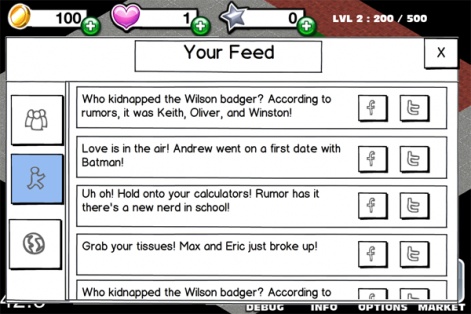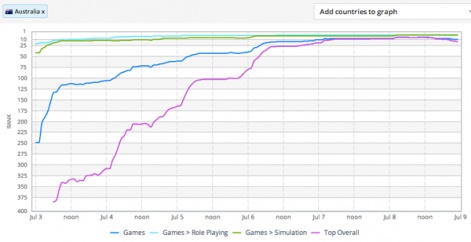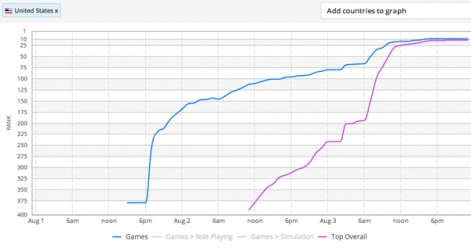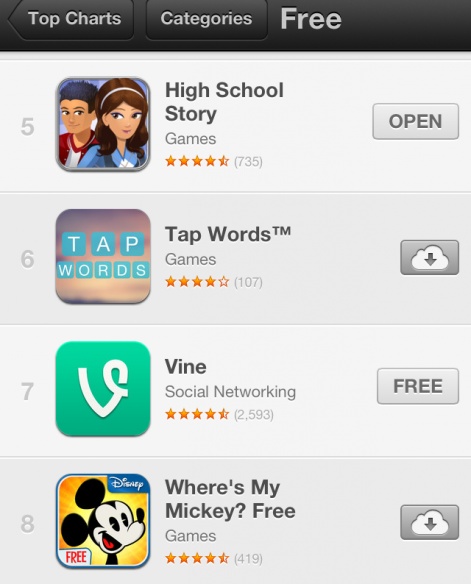PocketGamer.biz has partnered up with US developer Pixelberry Studios to highlight its candid stories on the trials and triumphs of a startup game studio whose debut title High School Story stayed in the top grossing top 100 chart for a year.
This bi-weekly series of articles will provide a mix of drama, detailed learnings, and actual numbers from their experience launching and supporting a top game.
Topics covered will include design, analytics, marketing, support, and making a difference.
Nowadays, keeping a game in the Top 100 Grossing chart requires more than just having a great product. You need a user acquisition strategy, too.
Some companies rely on multi-million dollar licensing deals to help draw players to their games, others rely on pulling users over from their existing network of games, but nearly all of them spend significant money on ads.
And if you’re not spending money to acquire new users, it’s very difficult to stay competitive.
Learning to spend
Our studio, Pixelberry, had years of working together as a team creating successful mobile products. But when it came to user acquisition (UA) we had zero experience; other teams had always handled marketing for us.
So a year before we launched High School Story, I began spending a lot of time trying to learn about user acquisition.

I was trying to figure out how much money was needed for a major game launch and how we should best spend that money.
I started by reading articles and blog posts about user acquisition and then started talking to various ad vendors in the space. But the information I received was never specific enough to help me actually plan a launch campaign for our game.
I eventually cold emailed a few developers who were gracious enough to discuss what they were doing with the understanding that I’d be available to pass back any learnings in the future.
Most of them recommended bursting with a few companies that specialized in bursting apps into the top 10. Bursting seemed promising, until the marketing companies that enabled you to burst through their specialized applications were banned from the App Store.
Eventually, I realized that we had three choices:
- I could learn how to do UA myself.
- We could hire an UA expert.
- We could work with a partner that would handle all of our UA.
Choices, choices
I decided against learning it myself because I wanted to spend more time helping to make our product better. Plus the stakes, the success of our studio, were too high for me to risk a mistake.
I knew if we launched with a bad marketing strategy, it could destroy our studio.
I knew if we launched with a bad marketing strategy, it could destroy our studio.
Hiring someone with UA experience was the obvious solution, but it would be difficult to find someone with a lot of experience who would take a chance on a bootstrapped start-up. So I started looking for a partner.
After talking to several companies, I was introduced to a company called Grow Mobile. Two of their founders had direct UA experience at Storm 8 and Zynga. It was obvious they knew what they were doing. And their business model of taking a percentage of our total marketing spend worked for us.
I was getting ready to sign a deal with them, when someone I trusted told me that he had heard some questionable things about some of the people at the company. I began doubting my decision.

But my main contact at Grow Mobile had always seemed very open and was giving me advice to spend with other channels, like Facebook, too - even though it would be splitting off some of our overall UA budget away from Grow. In the end, their knowledge, their belief in our product, and their willingness to look out for Pixelberry’s best interests won me over.
Knowing when to spend
Grow Mobile worked with me on a strategy to budget $100k for launch marketing, but to not spend it until 2 weeks after launch. I learned that some companies budgeted $250k for launch, while a few rare exceptions would budget over $1 million for their launch UA budget.
It was tempting to not spend money for our launch in the US.
But they felt confident that $100k would be a large and ample start for High School Story. Grow Mobile would try to spend the majority of the money on the first day across a number of different providers and then use the rest to keep the momentum going. The entire budget would be spent in the US, our main target market.
As you may know from our previous articles, during soft launch, our game rose into the Top 10 Free in Australia and Canada. Based on those results, it was tempting to not spend money for our launch in the US, but I had heard that moving up the Top Free chart in the US was much more difficult because of all the money that various companies spend not only on launch campaigns, but also on sustaining the position of their games in the the charts.
We spent well over a million dollars on the development of High School Story, so skimping on the launch didn’t make sense.

Then, a week before we launched our game, an opportunity for some promotion from another developer came up. But because of the their timing, we could only get that promotion on our third day of launch, 3 August 2013. So I decided to move our $100k launch spend up to the third day of launch to maximize our chances for peaking in the Top Free charts.
Fortunately, the Grow Mobile team was able to adjust their campaigns to accommodate the last minute change.
As this chart from AppFigures shows, everything worked splendidly. By the night of 3 August, we had hit #11 in Top Free.

And to our whole team’s surprise, we learned that the Grow team actually only spent $42k out of the $100k budget.
We were raiding our personal accounts so we could keep the UA spend going.
The following days they spent $11k, $5k, $12k, $14k, and $20k to keep our momentum going.
They spent this money across nearly a dozen ad networks, including Applifier, AppLovin, Iddiction, NativeX, and Vungle.
And since we were moving up in the Top Grossing charts and earning our marketing money back, my co-founders and I were raiding our personal accounts and making loans to the company so we could keep the UA spend going.
But as my co-founders and I like to say, this was a good problem to have.

Different next time around
Even though our launch of High School Story was successful, we’re changing our strategy for the launch of Pixelberry’s second game this December.
UA is not just about a launch budget, but about a long term sustained strategy.
We’ve since learned that UA is not just about a launch budget, but about a long term sustained strategy. We’ve learned that it’s best to let as many free, organic users find your game first before you turn on the power of the UA engine.
We will still have a launch budget ready and will have Grow Mobile campaigns on standby, but now we’ll wait for the natural peak first before making a day by day decision whether to let the peak crest or to spend to increase the high water mark in Top Free.
Of course, launching in December brings with it the problem of high CPIs and timing the peak before Christmas Day. But hopefully this time around we’ll have High School Story helping to spread the word about her new sister game.
If you’re as curious as we are as to whether this new strategy will work, make sure to check back on this series after December.
Next - Why Our CEO Almost Left Gaming
Oliver Miao is the CEO of Pixelberry Studios.
Through partnerships with non-profits, Pixelberry's hit game High School Story has taught millions of players about tough teen issues, like cyberbullying and eating disorders.
You can find out more at pixelberrystudios.com





















